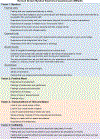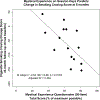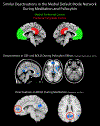Classic Hallucinogens and Mystical Experiences: Phenomenology and Neural Correlates
- PMID: 28401522
- PMCID: PMC6707356
- DOI: 10.1007/7854_2017_474
Classic Hallucinogens and Mystical Experiences: Phenomenology and Neural Correlates
Abstract
This chapter begins with a brief review of descriptions and definitions of mystical-type experiences and the historical connection between classic hallucinogens and mystical experiences. The chapter then explores the empirical literature on experiences with classic hallucinogens in which claims about mystical or religious experiences have been made. A psychometrically validated questionnaire is described for the reliable measurement of mystical-type experiences occasioned by classic hallucinogens. Controlled laboratory studies show that under double-blind conditions that provide significant controls for expectancy bias, psilocybin can occasion complete mystical experiences in the majority of people studied. These effects are dose-dependent, specific to psilocybin compared to placebo or a psychoactive control substance, and have enduring impact on the moods, attitudes, and behaviors of participants as assessed by self-report of participants and ratings by community observers. Other studies suggest that enduring personal meaning in healthy volunteers and therapeutic outcomes in patients, including reduction and cessation of substance abuse behaviors and reduction of anxiety and depression in patients with a life-threatening cancer diagnosis, are related to the occurrence of mystical experiences during drug sessions. The final sections of the chapter draw parallels in human neuroscience research between the neural bases of experiences with classic hallucinogens and the neural bases of meditative practices for which claims of mystical-type experience are sometimes made. From these parallels, a functional neural model of mystical experience is proposed, based on changes in the default mode network of the brain that have been observed after the administration of classic hallucinogens and during meditation practices for which mystical-type claims have been made.
Keywords: Angular gyrus; Default mode network; Hallucinogens; Inferior parietal lobule; Medial prefrontal cortex; Meditation; Mystical experiences; Neural model; Posterior cingulate; Psilocybin.
Figures







Similar articles
-
Psilocybin-occasioned mystical-type experience in combination with meditation and other spiritual practices produces enduring positive changes in psychological functioning and in trait measures of prosocial attitudes and behaviors.J Psychopharmacol. 2018 Jan;32(1):49-69. doi: 10.1177/0269881117731279. Epub 2017 Oct 11. J Psychopharmacol. 2018. PMID: 29020861 Free PMC article. Clinical Trial.
-
Validation of the revised Mystical Experience Questionnaire in experimental sessions with psilocybin.J Psychopharmacol. 2015 Nov;29(11):1182-90. doi: 10.1177/0269881115609019. Epub 2015 Oct 6. J Psychopharmacol. 2015. PMID: 26442957 Free PMC article.
-
Classic psychedelics: An integrative review of epidemiology, therapeutics, mystical experience, and brain network function.Pharmacol Ther. 2019 May;197:83-102. doi: 10.1016/j.pharmthera.2018.11.010. Epub 2018 Dec 4. Pharmacol Ther. 2019. PMID: 30521880 Review.
-
Psilocybin can occasion mystical-type experiences having substantial and sustained personal meaning and spiritual significance.Psychopharmacology (Berl). 2006 Aug;187(3):268-83; discussion 284-92. doi: 10.1007/s00213-006-0457-5. Epub 2006 Jul 7. Psychopharmacology (Berl). 2006. PMID: 16826400 Clinical Trial.
-
Psilocybin occasioned mystical-type experiences.Hum Psychopharmacol. 2020 Sep;35(5):e2742. doi: 10.1002/hup.2742. Epub 2020 Jun 23. Hum Psychopharmacol. 2020. PMID: 32573835 Review.
Cited by
-
Autonomic nervous system activity correlates with peak experiences induced by DMT and predicts increases in well-being.J Psychopharmacol. 2024 Oct;38(10):887-896. doi: 10.1177/02698811241276788. Epub 2024 Sep 20. J Psychopharmacol. 2024. PMID: 39301949 Free PMC article. Clinical Trial.
-
Large-scale brain connectivity changes following the administration of lysergic acid diethylamide, d-amphetamine, and 3,4-methylenedioxyamphetamine.Mol Psychiatry. 2024 Sep 11. doi: 10.1038/s41380-024-02734-y. Online ahead of print. Mol Psychiatry. 2024. PMID: 39261671
-
LSD-assisted therapy in patients with anxiety: open-label prospective 12-month follow-up.Br J Psychiatry. 2024 Sep;225(3):362-370. doi: 10.1192/bjp.2024.99. Br J Psychiatry. 2024. PMID: 39078038 Free PMC article. Clinical Trial.
-
Disentangling the acute subjective effects of classic psychedelics from their enduring therapeutic properties.Psychopharmacology (Berl). 2024 May 14. doi: 10.1007/s00213-024-06599-5. Online ahead of print. Psychopharmacology (Berl). 2024. PMID: 38743110 Review.
-
The potential of 5-methoxy-N,N-dimethyltryptamine in the treatment of alcohol use disorder: A first look at therapeutic mechanisms of action.Addict Biol. 2024 Apr;29(4):e13386. doi: 10.1111/adb.13386. Addict Biol. 2024. PMID: 38600715 Free PMC article. Review.
References
-
- Aaronson BS & Osmond H (1970). Introduction: Psychedelics, Technology, Psychedelics In Aaronson BS & Osmond H (Eds.), Psychedelics: The Uses and Implications of Hallucinogenic Drugs (pp. 3–20). New York: Anchor Books.
-
- Anthony FV, Hermans CAM, & Sterkens C (2010). A Comparative Study of Mystical Experience Among Christian, Muslim, and Hindu Students in Tamil Nadu, India. Journal for the Scientific Study of Religion, 49(2), 264–277.
Publication types
MeSH terms
Substances
Grants and funding
LinkOut - more resources
Full Text Sources
Other Literature Sources


